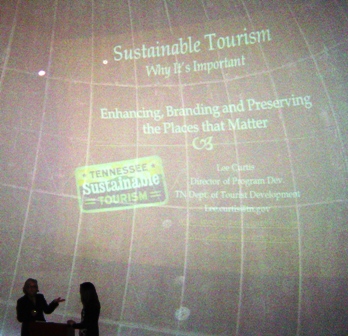Mary Potter/ Photos by Ivan Potter
Sunday, February 27, 2011 8:05 pm
Here’s the bad news: Tennessee is going to kick Kentucky’s butt in tourist dollars this summer. The good news: Tennessee’s tourism officials are more than willing to share what they’ve learned with other states. Whether it will be enough to help Kentucky businesses reliant on tourism remains to be seen.

On the drawing board: a “Moonshine Tour” of northeastern Tennessee, keying on that region’s reputation for production of the homebrew alcohol. Other trails and tours link small towns and parks with similar interests.
Tennessee’s budget for tourism is $6 million. Officials predict that will produce $13 billion dollars of income for the Volunteer State, according to a December 2010 story in the Memphis paper.
Another neighbor state, Missouri, spends $13.4 million on tourism and reaps $53 for each dollar spent. That’s a $710 million dollars return on investment.
Discovering Kentucky’s tourism budget wasn’t in a news story like Tennessee’s or Missouri’s. The only information we could find on the budget was the pdf version of the state budget. We couldn’t find any return on investment information for the Bluegrass State.
Kentucky revamped what was once called the Commerce Cabinet into the Tourism, Arts and Heritage Cabinet. The total revised budget for the Cabinet was $52 million in 2010 and $49 million in 2011. Within the Cabinet, the budget for the Department for Travel and Tourism was $3.5 million in 2010 and $3.3 million in 2011.
One of Tennessee’s tourism officials, Lee Waddell Curtis, Director of Program Development for the Tennessee Department of Tourist Development, recently shared her state’s plans at the Land Between the Lakes Small Business Seminar on Saturday, February 19th.
Curtis’ topic, “Sustainable Development: Why’s It Important?” was part of a daylong program on building a sustainable tourism business. Attendees seated in the Golden Pond Planetarium heard presenters speak on getting state assistance, creating a business plan and the benefits of having a website. Then they were treated to a site tour of the Woodlands Nature Station.
Curtis said that sustainable tourism is “sustaining the environment, culture and heritage of a region while at the same time sustaining the economic growth through tourism.” Tennessee came up with the sustainability theme after surveying visitors to the state. Eco-friendly hotels, solar powered touris
Curtis told her audience that Tennessee is blessed with three distinct regions- east, west and center. The state targets audiences for each region. For example, West Tennessee is marketed in a triangle from Chicago to St. Louis to New Orleans. East Tennessee has a different target market. Tourism officials advertise Eastern Tennessee’s attractions in Atlanta and cities to the north and east.
Kentucky’s twin tourism themes have been adventure tourism and horse related attractions. Adventure tourism includes such activities as backpacking, trail rides and four wheeling. Lt. Governor Dan Mongiardo was an early enthusiast for adventure tourism. Horse related events include the World Equestrian Games, the Kentucky Derby and trail riding opportunities. First Lady Jane Beshear, a horsewoman, is a major supporter of equestrian tourism.
Kentucky and Tennessee should be equally attractive to tourists. They both have great parks and recreational areas. They both have metropolitan areas that should be equally attractive to conventions and large groups. They are both located in the center of the country, within driving distance of millions of potential tourists.
The differences between the two states are in leadership, focus and direction. One has it and the other doesn’t.
And that’s why Tennessee is gonna kick Kentucky’s tourism dollar butt this summer.